HI6005: Change Management Research Paper and Presentation
VerifiedAdded on 2023/01/04
|18
|4317
|82
Report
AI Summary
This research paper and presentation delve into the multifaceted world of change management, examining its various aspects and practical applications. The report begins by introducing the core concepts, including the contrasting metaphors of "calm waters" and "white-water rapids" to illustrate different perspectives on organizational change. It then proceeds to analyze key change management models, such as Kotter's theory and Force-field analysis, to provide a structured framework for understanding and implementing change. Furthermore, the paper explores the critical role of organizational culture in successful change initiatives. The report incorporates a detailed analysis of an IBM case study to provide real-world insights and demonstrate the practical application of change management principles. The research covers topics like Kotter’s change management model, Force Field analysis, changing organizational culture and IBM case study analysis.
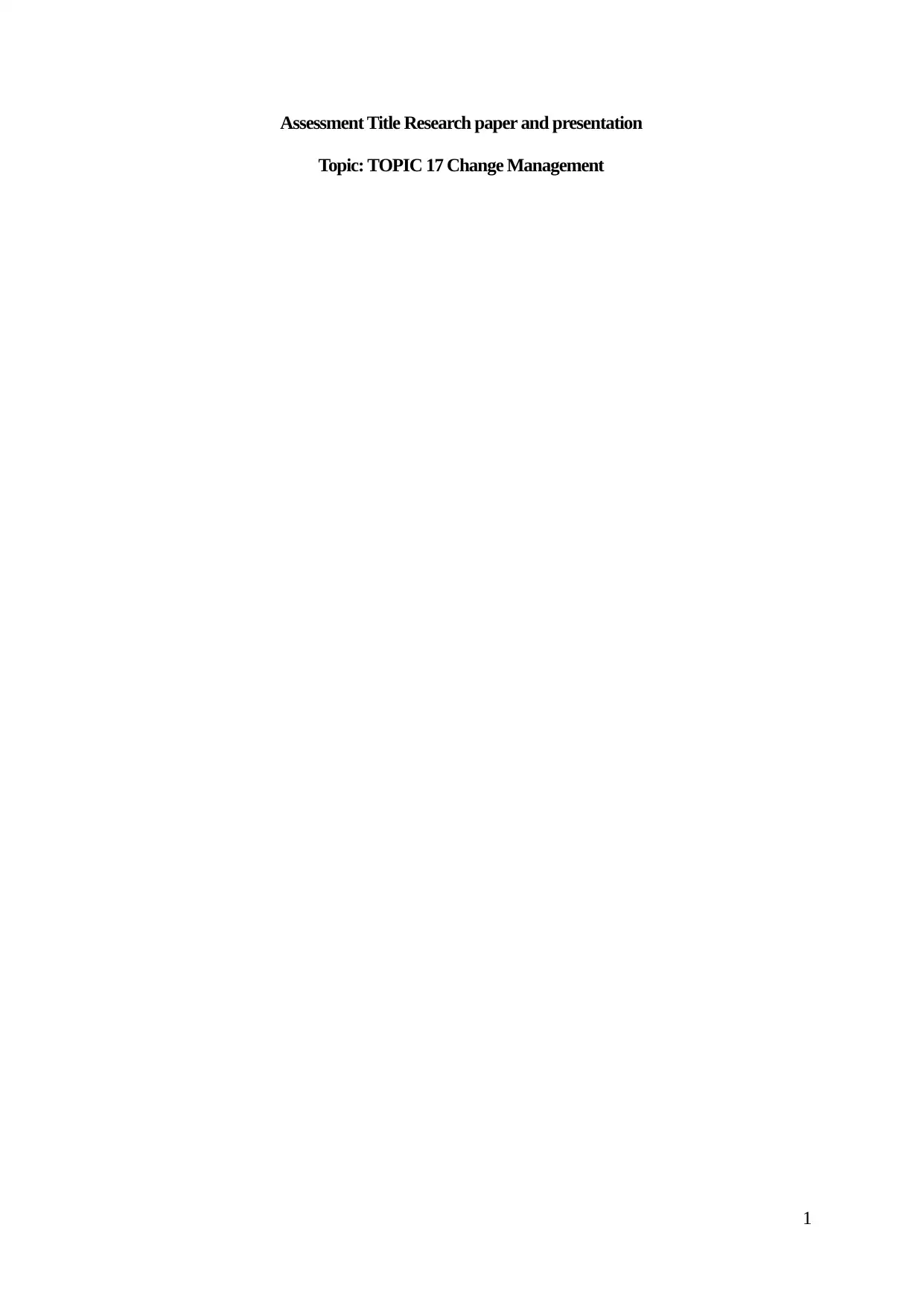
Assessment Title Research paper and presentation
Topic: TOPIC 17 Change Management
1
Topic: TOPIC 17 Change Management
1
Paraphrase This Document
Need a fresh take? Get an instant paraphrase of this document with our AI Paraphraser
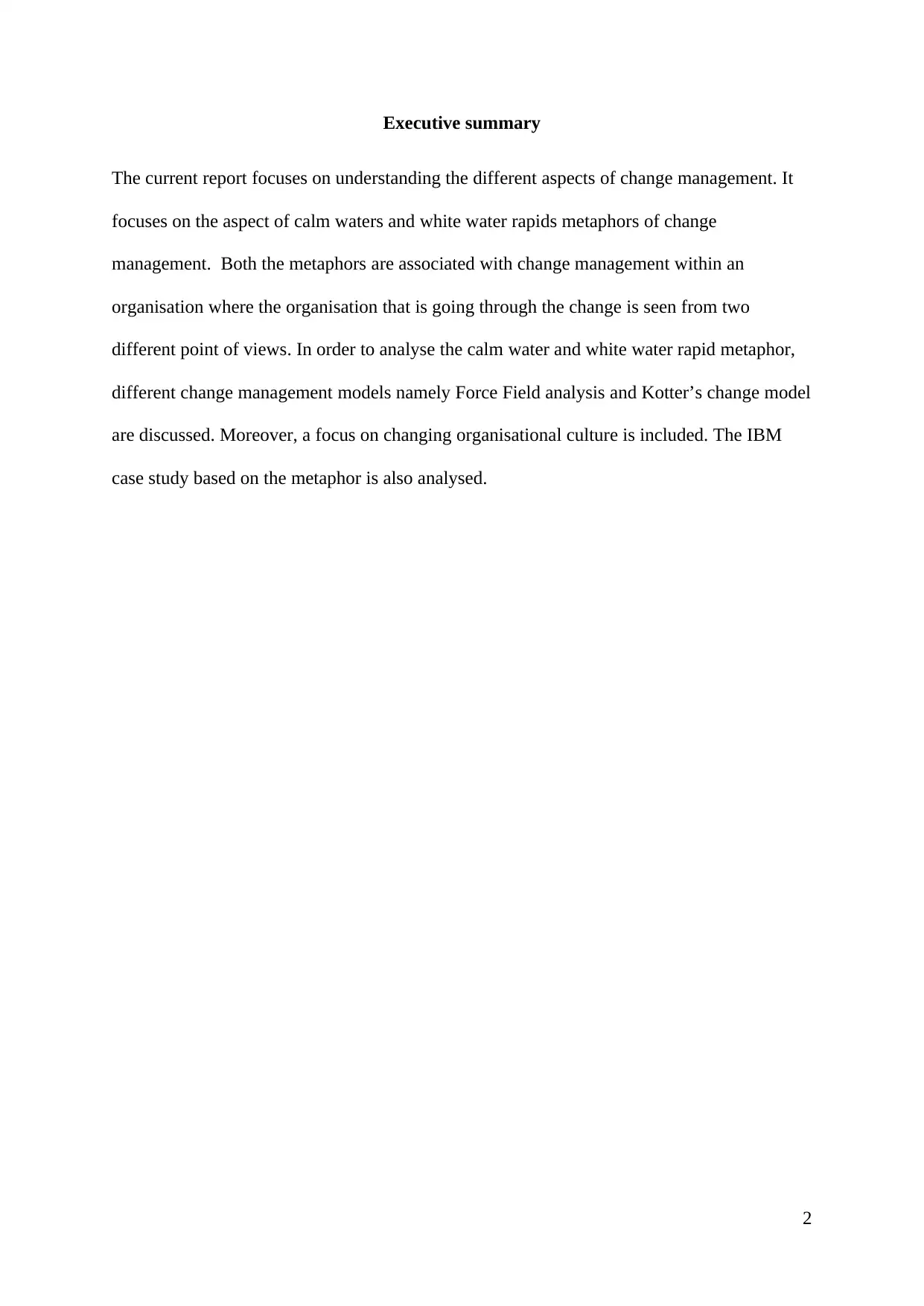
Executive summary
The current report focuses on understanding the different aspects of change management. It
focuses on the aspect of calm waters and white water rapids metaphors of change
management. Both the metaphors are associated with change management within an
organisation where the organisation that is going through the change is seen from two
different point of views. In order to analyse the calm water and white water rapid metaphor,
different change management models namely Force Field analysis and Kotter’s change model
are discussed. Moreover, a focus on changing organisational culture is included. The IBM
case study based on the metaphor is also analysed.
2
The current report focuses on understanding the different aspects of change management. It
focuses on the aspect of calm waters and white water rapids metaphors of change
management. Both the metaphors are associated with change management within an
organisation where the organisation that is going through the change is seen from two
different point of views. In order to analyse the calm water and white water rapid metaphor,
different change management models namely Force Field analysis and Kotter’s change model
are discussed. Moreover, a focus on changing organisational culture is included. The IBM
case study based on the metaphor is also analysed.
2
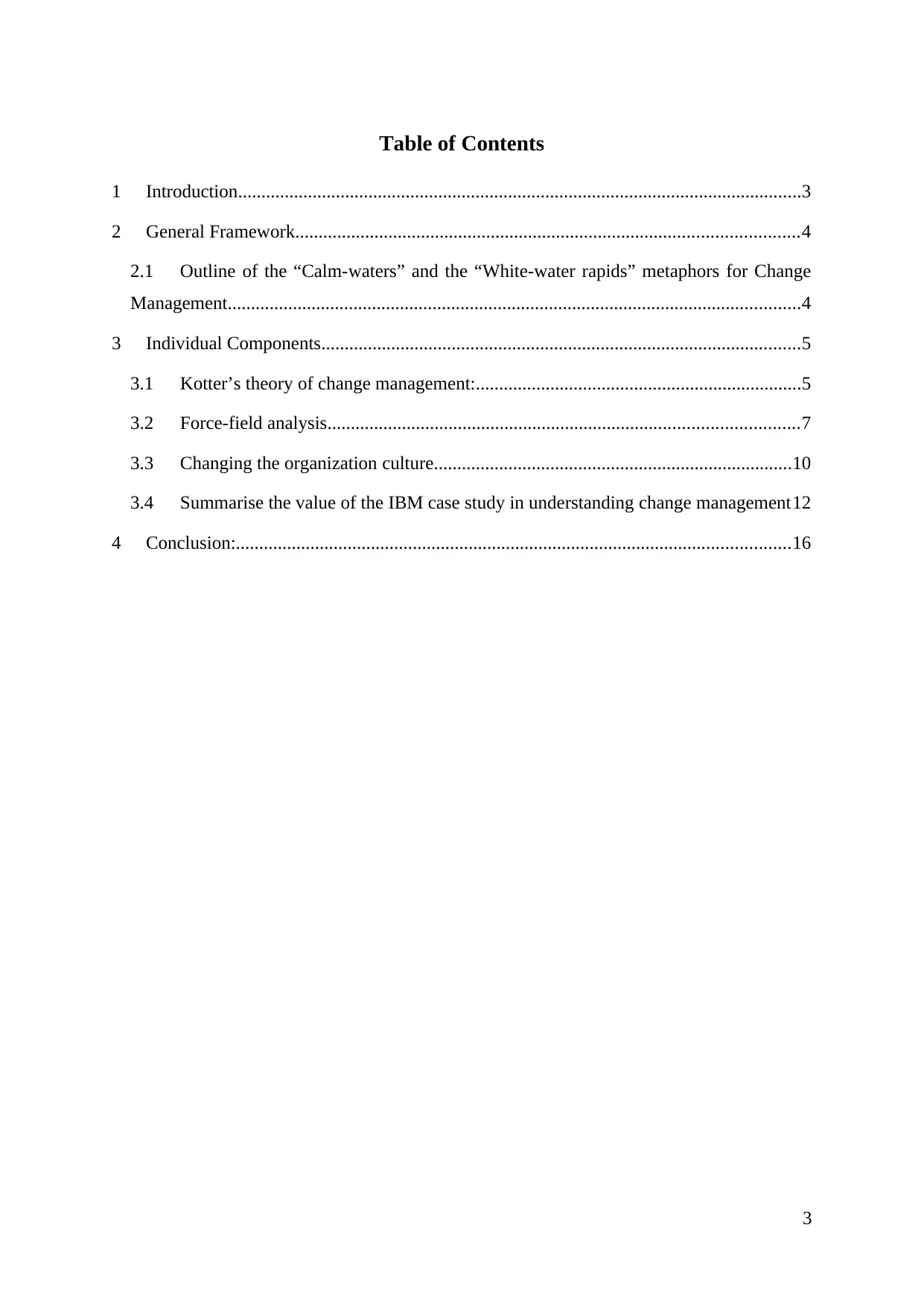
Table of Contents
1 Introduction.........................................................................................................................3
2 General Framework............................................................................................................4
2.1 Outline of the “Calm-waters” and the “White-water rapids” metaphors for Change
Management...........................................................................................................................4
3 Individual Components.......................................................................................................5
3.1 Kotter’s theory of change management:......................................................................5
3.2 Force-field analysis.....................................................................................................7
3.3 Changing the organization culture.............................................................................10
3.4 Summarise the value of the IBM case study in understanding change management12
4 Conclusion:.......................................................................................................................16
3
1 Introduction.........................................................................................................................3
2 General Framework............................................................................................................4
2.1 Outline of the “Calm-waters” and the “White-water rapids” metaphors for Change
Management...........................................................................................................................4
3 Individual Components.......................................................................................................5
3.1 Kotter’s theory of change management:......................................................................5
3.2 Force-field analysis.....................................................................................................7
3.3 Changing the organization culture.............................................................................10
3.4 Summarise the value of the IBM case study in understanding change management12
4 Conclusion:.......................................................................................................................16
3
⊘ This is a preview!⊘
Do you want full access?
Subscribe today to unlock all pages.

Trusted by 1+ million students worldwide
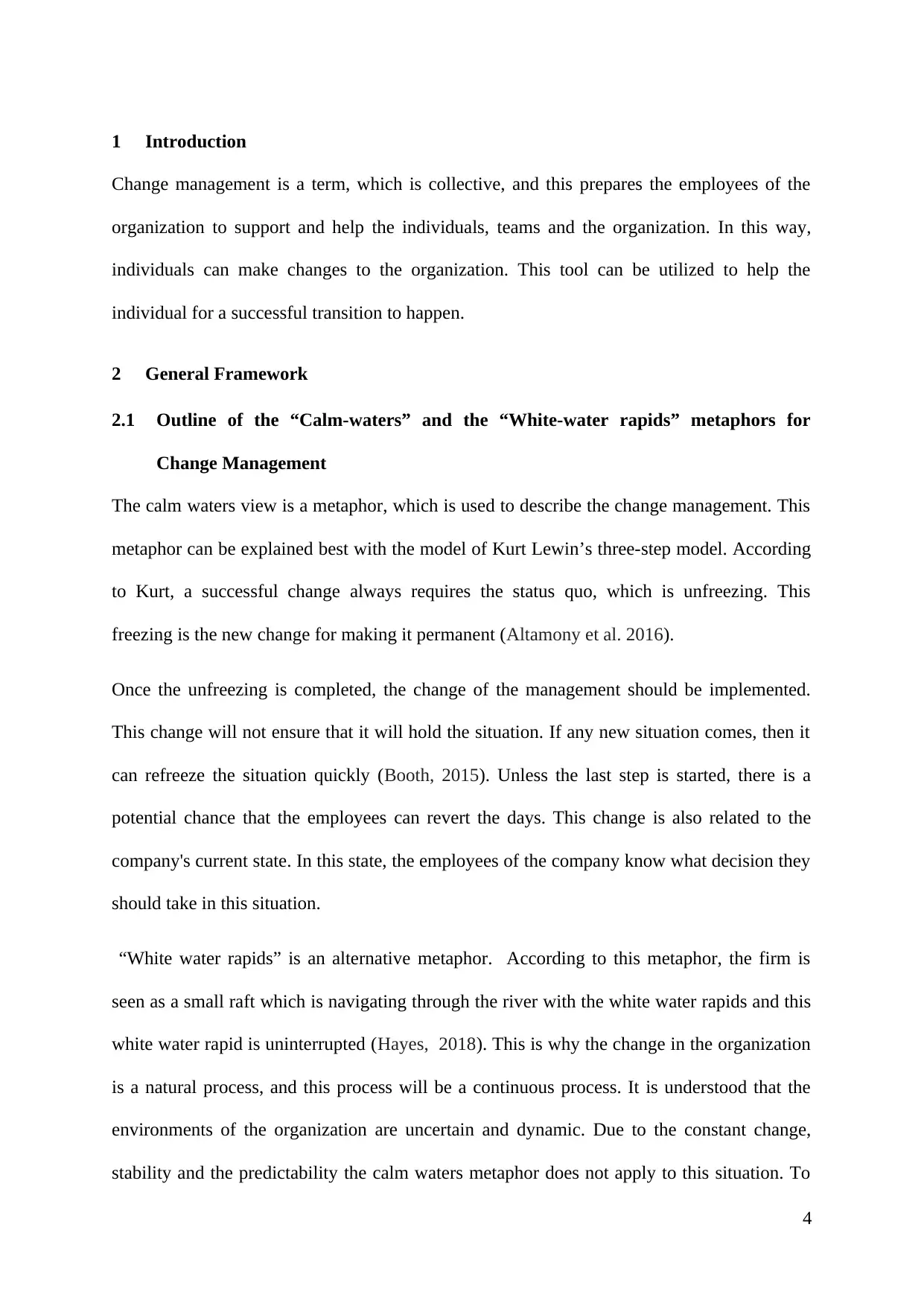
1 Introduction
Change management is a term, which is collective, and this prepares the employees of the
organization to support and help the individuals, teams and the organization. In this way,
individuals can make changes to the organization. This tool can be utilized to help the
individual for a successful transition to happen.
2 General Framework
2.1 Outline of the “Calm-waters” and the “White-water rapids” metaphors for
Change Management
The calm waters view is a metaphor, which is used to describe the change management. This
metaphor can be explained best with the model of Kurt Lewin’s three-step model. According
to Kurt, a successful change always requires the status quo, which is unfreezing. This
freezing is the new change for making it permanent (Altamony et al. 2016).
Once the unfreezing is completed, the change of the management should be implemented.
This change will not ensure that it will hold the situation. If any new situation comes, then it
can refreeze the situation quickly (Booth, 2015). Unless the last step is started, there is a
potential chance that the employees can revert the days. This change is also related to the
company's current state. In this state, the employees of the company know what decision they
should take in this situation.
“White water rapids” is an alternative metaphor. According to this metaphor, the firm is
seen as a small raft which is navigating through the river with the white water rapids and this
white water rapid is uninterrupted (Hayes, 2018). This is why the change in the organization
is a natural process, and this process will be a continuous process. It is understood that the
environments of the organization are uncertain and dynamic. Due to the constant change,
stability and the predictability the calm waters metaphor does not apply to this situation. To
4
Change management is a term, which is collective, and this prepares the employees of the
organization to support and help the individuals, teams and the organization. In this way,
individuals can make changes to the organization. This tool can be utilized to help the
individual for a successful transition to happen.
2 General Framework
2.1 Outline of the “Calm-waters” and the “White-water rapids” metaphors for
Change Management
The calm waters view is a metaphor, which is used to describe the change management. This
metaphor can be explained best with the model of Kurt Lewin’s three-step model. According
to Kurt, a successful change always requires the status quo, which is unfreezing. This
freezing is the new change for making it permanent (Altamony et al. 2016).
Once the unfreezing is completed, the change of the management should be implemented.
This change will not ensure that it will hold the situation. If any new situation comes, then it
can refreeze the situation quickly (Booth, 2015). Unless the last step is started, there is a
potential chance that the employees can revert the days. This change is also related to the
company's current state. In this state, the employees of the company know what decision they
should take in this situation.
“White water rapids” is an alternative metaphor. According to this metaphor, the firm is
seen as a small raft which is navigating through the river with the white water rapids and this
white water rapid is uninterrupted (Hayes, 2018). This is why the change in the organization
is a natural process, and this process will be a continuous process. It is understood that the
environments of the organization are uncertain and dynamic. Due to the constant change,
stability and the predictability the calm waters metaphor does not apply to this situation. To
4
Paraphrase This Document
Need a fresh take? Get an instant paraphrase of this document with our AI Paraphraser
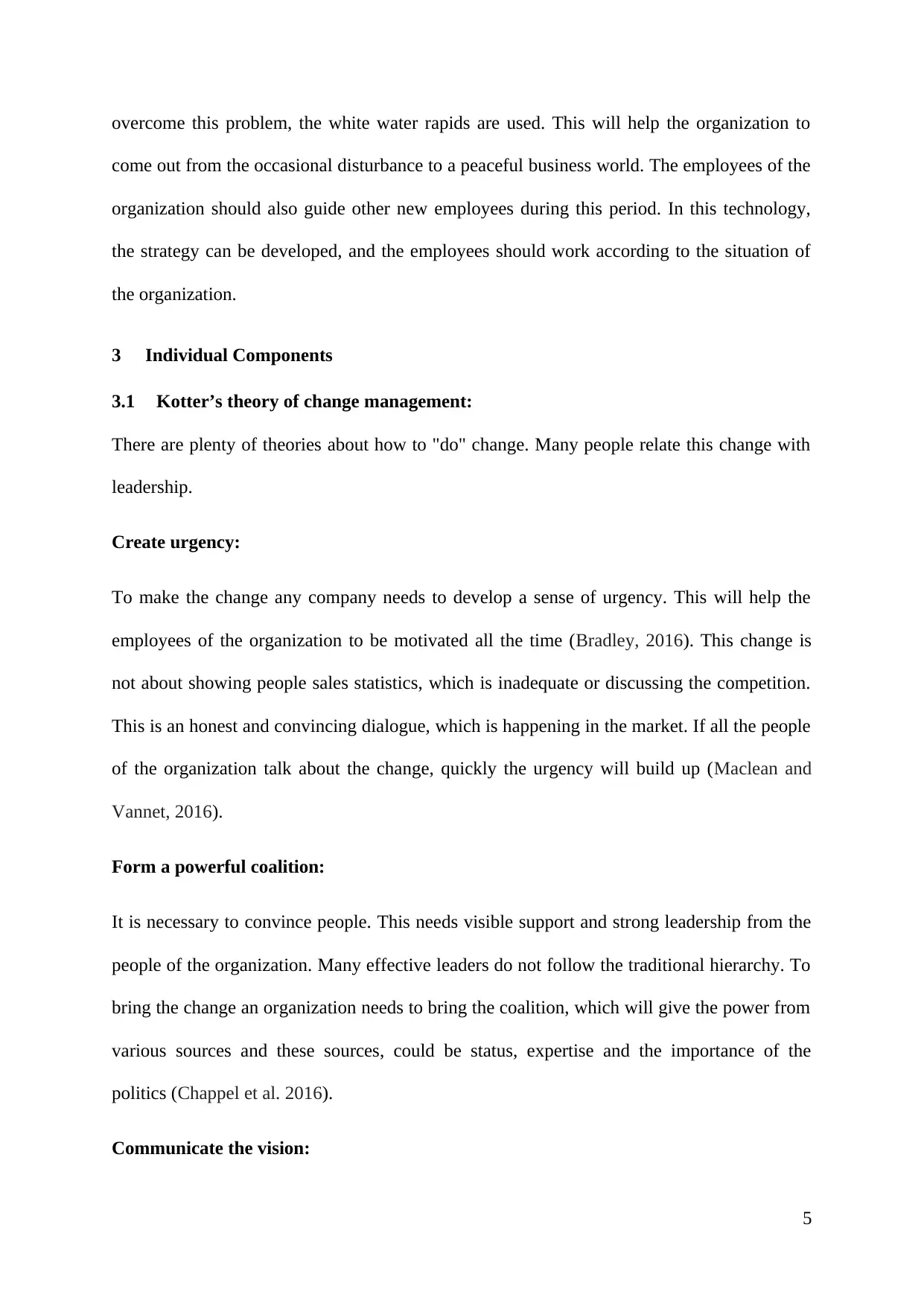
overcome this problem, the white water rapids are used. This will help the organization to
come out from the occasional disturbance to a peaceful business world. The employees of the
organization should also guide other new employees during this period. In this technology,
the strategy can be developed, and the employees should work according to the situation of
the organization.
3 Individual Components
3.1 Kotter’s theory of change management:
There are plenty of theories about how to "do" change. Many people relate this change with
leadership.
Create urgency:
To make the change any company needs to develop a sense of urgency. This will help the
employees of the organization to be motivated all the time (Bradley, 2016). This change is
not about showing people sales statistics, which is inadequate or discussing the competition.
This is an honest and convincing dialogue, which is happening in the market. If all the people
of the organization talk about the change, quickly the urgency will build up (Maclean and
Vannet, 2016).
Form a powerful coalition:
It is necessary to convince people. This needs visible support and strong leadership from the
people of the organization. Many effective leaders do not follow the traditional hierarchy. To
bring the change an organization needs to bring the coalition, which will give the power from
various sources and these sources, could be status, expertise and the importance of the
politics (Chappel et al. 2016).
Communicate the vision:
5
come out from the occasional disturbance to a peaceful business world. The employees of the
organization should also guide other new employees during this period. In this technology,
the strategy can be developed, and the employees should work according to the situation of
the organization.
3 Individual Components
3.1 Kotter’s theory of change management:
There are plenty of theories about how to "do" change. Many people relate this change with
leadership.
Create urgency:
To make the change any company needs to develop a sense of urgency. This will help the
employees of the organization to be motivated all the time (Bradley, 2016). This change is
not about showing people sales statistics, which is inadequate or discussing the competition.
This is an honest and convincing dialogue, which is happening in the market. If all the people
of the organization talk about the change, quickly the urgency will build up (Maclean and
Vannet, 2016).
Form a powerful coalition:
It is necessary to convince people. This needs visible support and strong leadership from the
people of the organization. Many effective leaders do not follow the traditional hierarchy. To
bring the change an organization needs to bring the coalition, which will give the power from
various sources and these sources, could be status, expertise and the importance of the
politics (Chappel et al. 2016).
Communicate the vision:
5
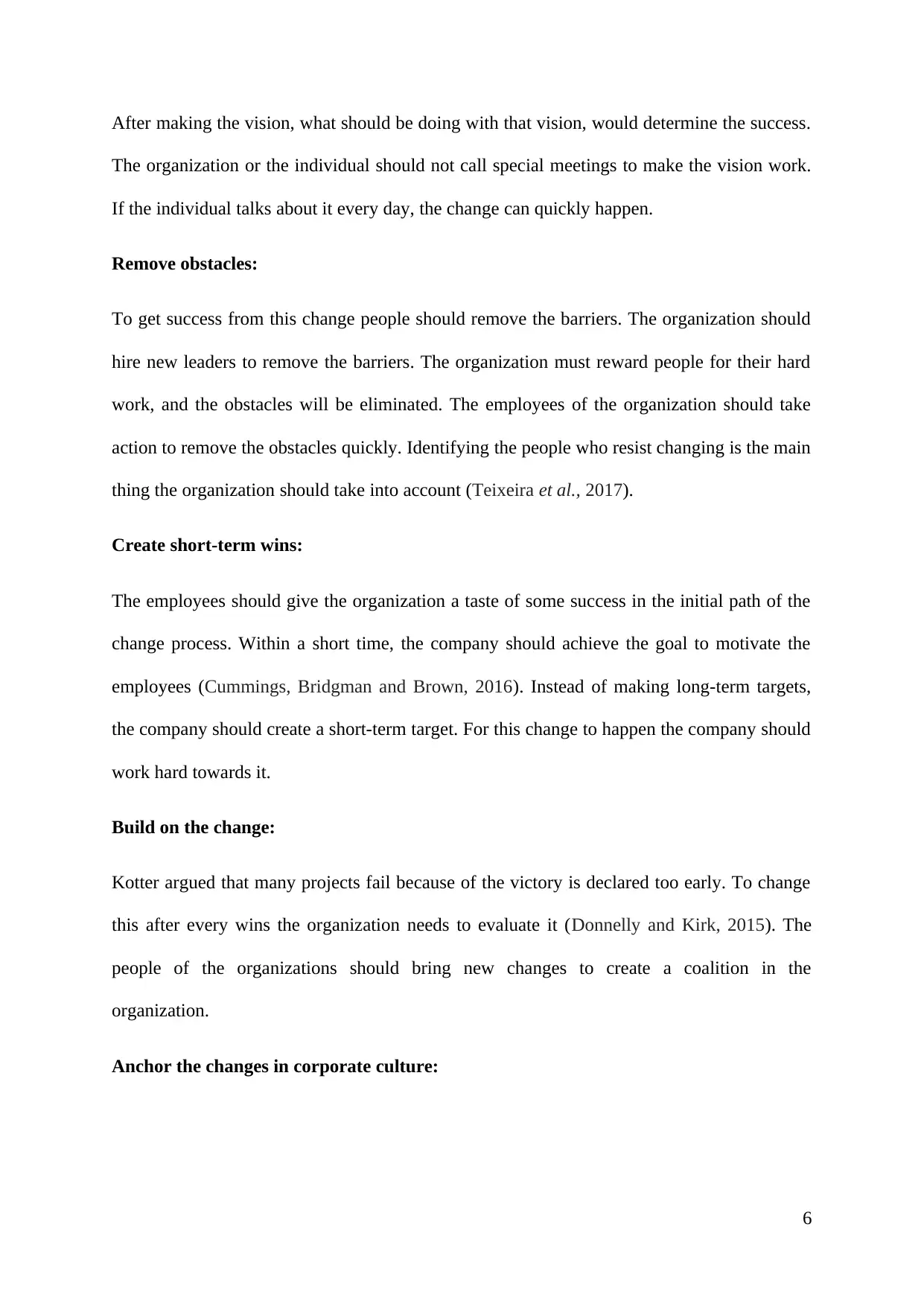
After making the vision, what should be doing with that vision, would determine the success.
The organization or the individual should not call special meetings to make the vision work.
If the individual talks about it every day, the change can quickly happen.
Remove obstacles:
To get success from this change people should remove the barriers. The organization should
hire new leaders to remove the barriers. The organization must reward people for their hard
work, and the obstacles will be eliminated. The employees of the organization should take
action to remove the obstacles quickly. Identifying the people who resist changing is the main
thing the organization should take into account (Teixeira et al., 2017).
Create short-term wins:
The employees should give the organization a taste of some success in the initial path of the
change process. Within a short time, the company should achieve the goal to motivate the
employees (Cummings, Bridgman and Brown, 2016). Instead of making long-term targets,
the company should create a short-term target. For this change to happen the company should
work hard towards it.
Build on the change:
Kotter argued that many projects fail because of the victory is declared too early. To change
this after every wins the organization needs to evaluate it (Donnelly and Kirk, 2015). The
people of the organizations should bring new changes to create a coalition in the
organization.
Anchor the changes in corporate culture:
6
The organization or the individual should not call special meetings to make the vision work.
If the individual talks about it every day, the change can quickly happen.
Remove obstacles:
To get success from this change people should remove the barriers. The organization should
hire new leaders to remove the barriers. The organization must reward people for their hard
work, and the obstacles will be eliminated. The employees of the organization should take
action to remove the obstacles quickly. Identifying the people who resist changing is the main
thing the organization should take into account (Teixeira et al., 2017).
Create short-term wins:
The employees should give the organization a taste of some success in the initial path of the
change process. Within a short time, the company should achieve the goal to motivate the
employees (Cummings, Bridgman and Brown, 2016). Instead of making long-term targets,
the company should create a short-term target. For this change to happen the company should
work hard towards it.
Build on the change:
Kotter argued that many projects fail because of the victory is declared too early. To change
this after every wins the organization needs to evaluate it (Donnelly and Kirk, 2015). The
people of the organizations should bring new changes to create a coalition in the
organization.
Anchor the changes in corporate culture:
6
⊘ This is a preview!⊘
Do you want full access?
Subscribe today to unlock all pages.

Trusted by 1+ million students worldwide
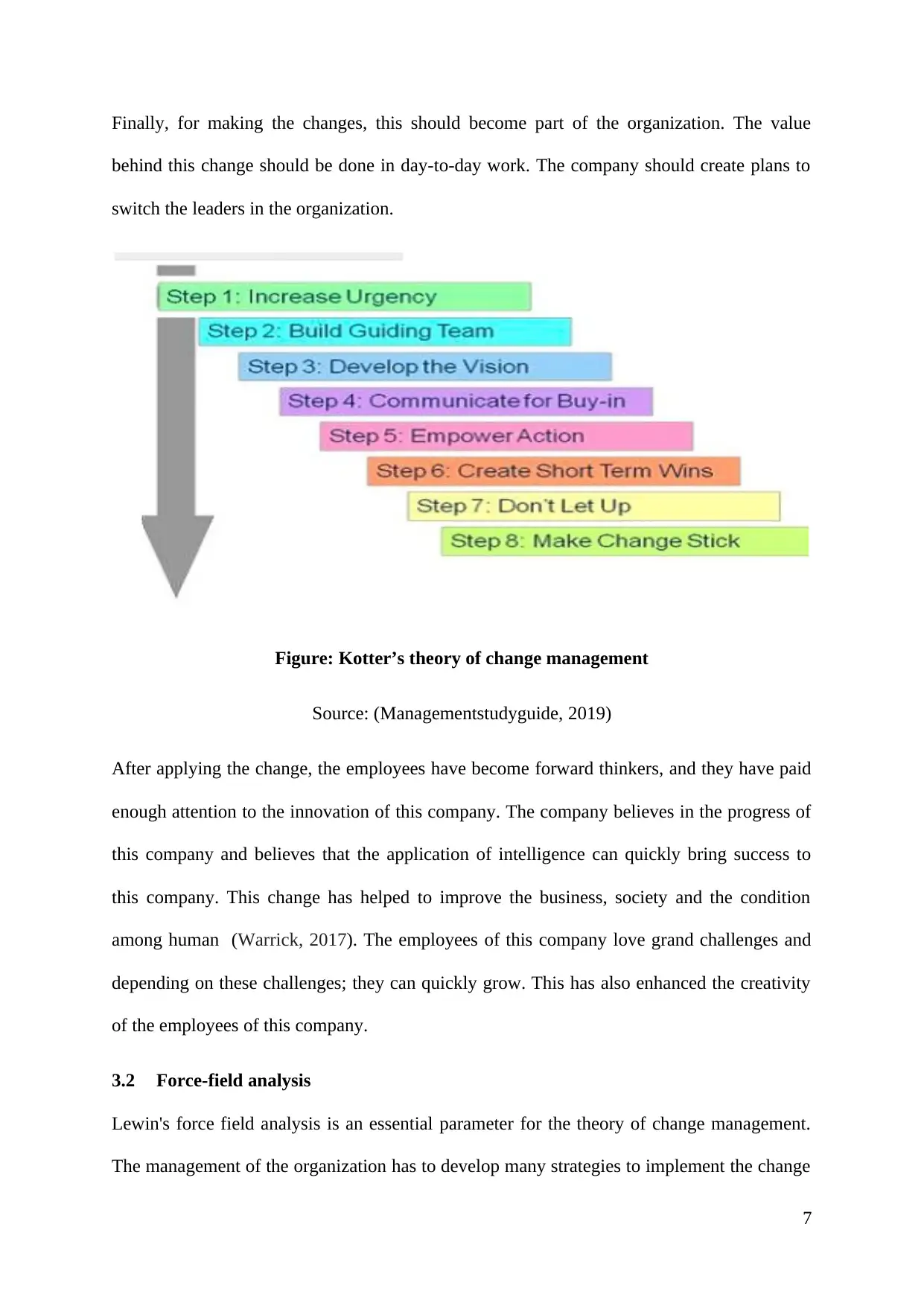
Finally, for making the changes, this should become part of the organization. The value
behind this change should be done in day-to-day work. The company should create plans to
switch the leaders in the organization.
Figure: Kotter’s theory of change management
Source: (Managementstudyguide, 2019)
After applying the change, the employees have become forward thinkers, and they have paid
enough attention to the innovation of this company. The company believes in the progress of
this company and believes that the application of intelligence can quickly bring success to
this company. This change has helped to improve the business, society and the condition
among human (Warrick, 2017). The employees of this company love grand challenges and
depending on these challenges; they can quickly grow. This has also enhanced the creativity
of the employees of this company.
3.2 Force-field analysis
Lewin's force field analysis is an essential parameter for the theory of change management.
The management of the organization has to develop many strategies to implement the change
7
behind this change should be done in day-to-day work. The company should create plans to
switch the leaders in the organization.
Figure: Kotter’s theory of change management
Source: (Managementstudyguide, 2019)
After applying the change, the employees have become forward thinkers, and they have paid
enough attention to the innovation of this company. The company believes in the progress of
this company and believes that the application of intelligence can quickly bring success to
this company. This change has helped to improve the business, society and the condition
among human (Warrick, 2017). The employees of this company love grand challenges and
depending on these challenges; they can quickly grow. This has also enhanced the creativity
of the employees of this company.
3.2 Force-field analysis
Lewin's force field analysis is an essential parameter for the theory of change management.
The management of the organization has to develop many strategies to implement the change
7
Paraphrase This Document
Need a fresh take? Get an instant paraphrase of this document with our AI Paraphraser
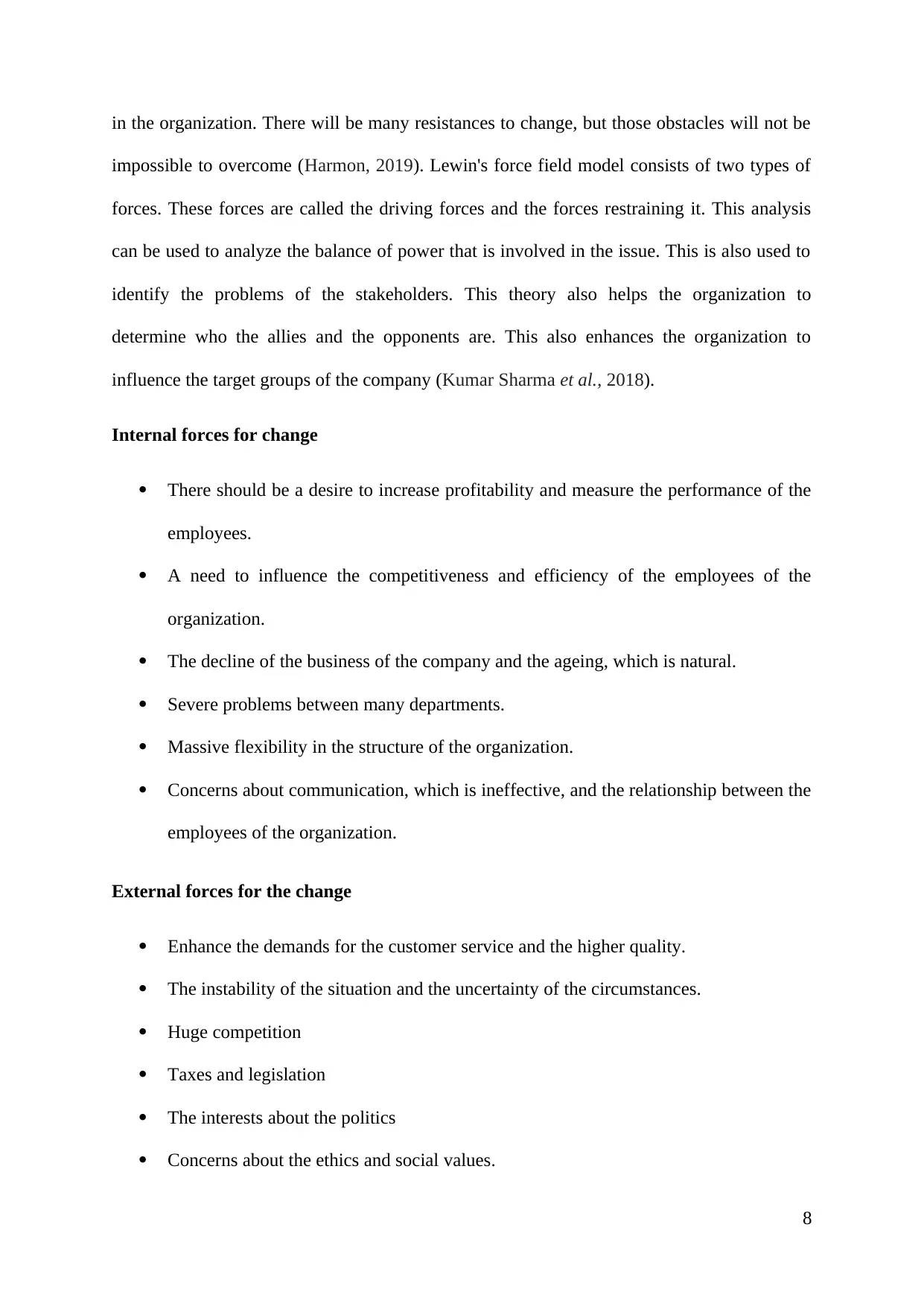
in the organization. There will be many resistances to change, but those obstacles will not be
impossible to overcome (Harmon, 2019). Lewin's force field model consists of two types of
forces. These forces are called the driving forces and the forces restraining it. This analysis
can be used to analyze the balance of power that is involved in the issue. This is also used to
identify the problems of the stakeholders. This theory also helps the organization to
determine who the allies and the opponents are. This also enhances the organization to
influence the target groups of the company (Kumar Sharma et al., 2018).
Internal forces for change
There should be a desire to increase profitability and measure the performance of the
employees.
A need to influence the competitiveness and efficiency of the employees of the
organization.
The decline of the business of the company and the ageing, which is natural.
Severe problems between many departments.
Massive flexibility in the structure of the organization.
Concerns about communication, which is ineffective, and the relationship between the
employees of the organization.
External forces for the change
Enhance the demands for the customer service and the higher quality.
The instability of the situation and the uncertainty of the circumstances.
Huge competition
Taxes and legislation
The interests about the politics
Concerns about the ethics and social values.
8
impossible to overcome (Harmon, 2019). Lewin's force field model consists of two types of
forces. These forces are called the driving forces and the forces restraining it. This analysis
can be used to analyze the balance of power that is involved in the issue. This is also used to
identify the problems of the stakeholders. This theory also helps the organization to
determine who the allies and the opponents are. This also enhances the organization to
influence the target groups of the company (Kumar Sharma et al., 2018).
Internal forces for change
There should be a desire to increase profitability and measure the performance of the
employees.
A need to influence the competitiveness and efficiency of the employees of the
organization.
The decline of the business of the company and the ageing, which is natural.
Severe problems between many departments.
Massive flexibility in the structure of the organization.
Concerns about communication, which is ineffective, and the relationship between the
employees of the organization.
External forces for the change
Enhance the demands for the customer service and the higher quality.
The instability of the situation and the uncertainty of the circumstances.
Huge competition
Taxes and legislation
The interests about the politics
Concerns about the ethics and social values.
8
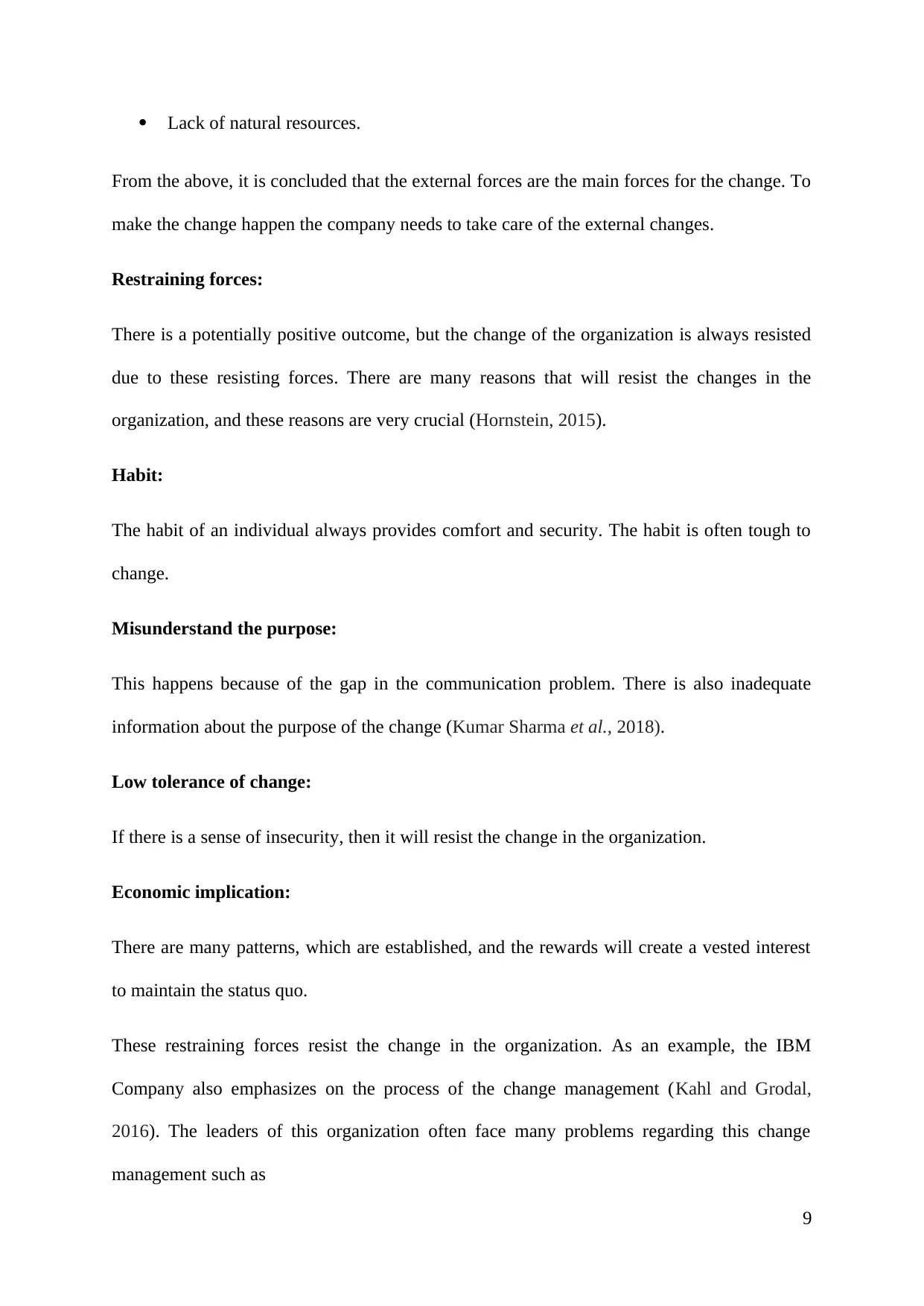
Lack of natural resources.
From the above, it is concluded that the external forces are the main forces for the change. To
make the change happen the company needs to take care of the external changes.
Restraining forces:
There is a potentially positive outcome, but the change of the organization is always resisted
due to these resisting forces. There are many reasons that will resist the changes in the
organization, and these reasons are very crucial (Hornstein, 2015).
Habit:
The habit of an individual always provides comfort and security. The habit is often tough to
change.
Misunderstand the purpose:
This happens because of the gap in the communication problem. There is also inadequate
information about the purpose of the change (Kumar Sharma et al., 2018).
Low tolerance of change:
If there is a sense of insecurity, then it will resist the change in the organization.
Economic implication:
There are many patterns, which are established, and the rewards will create a vested interest
to maintain the status quo.
These restraining forces resist the change in the organization. As an example, the IBM
Company also emphasizes on the process of the change management (Kahl and Grodal,
2016). The leaders of this organization often face many problems regarding this change
management such as
9
From the above, it is concluded that the external forces are the main forces for the change. To
make the change happen the company needs to take care of the external changes.
Restraining forces:
There is a potentially positive outcome, but the change of the organization is always resisted
due to these resisting forces. There are many reasons that will resist the changes in the
organization, and these reasons are very crucial (Hornstein, 2015).
Habit:
The habit of an individual always provides comfort and security. The habit is often tough to
change.
Misunderstand the purpose:
This happens because of the gap in the communication problem. There is also inadequate
information about the purpose of the change (Kumar Sharma et al., 2018).
Low tolerance of change:
If there is a sense of insecurity, then it will resist the change in the organization.
Economic implication:
There are many patterns, which are established, and the rewards will create a vested interest
to maintain the status quo.
These restraining forces resist the change in the organization. As an example, the IBM
Company also emphasizes on the process of the change management (Kahl and Grodal,
2016). The leaders of this organization often face many problems regarding this change
management such as
9
⊘ This is a preview!⊘
Do you want full access?
Subscribe today to unlock all pages.

Trusted by 1+ million students worldwide
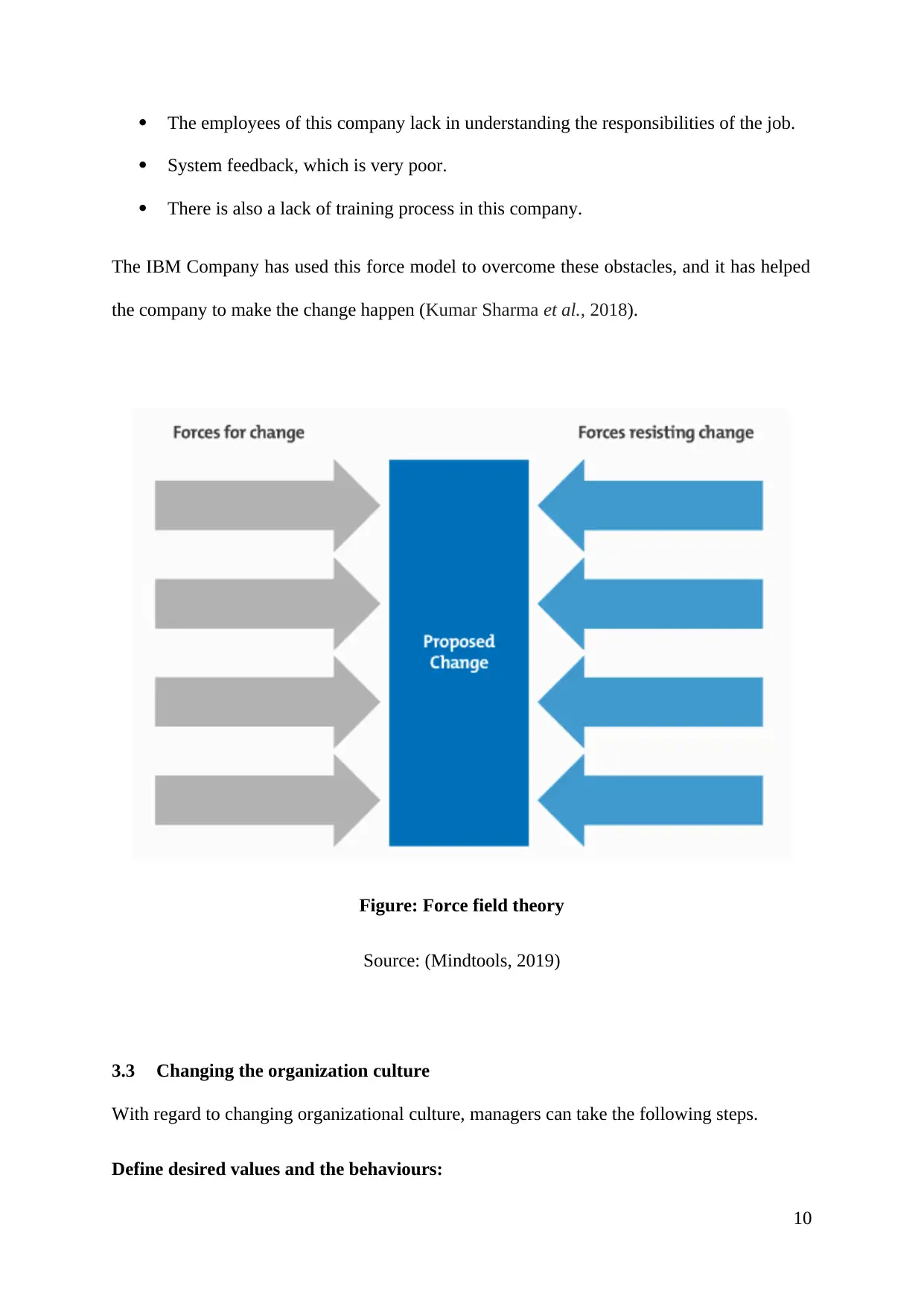
The employees of this company lack in understanding the responsibilities of the job.
System feedback, which is very poor.
There is also a lack of training process in this company.
The IBM Company has used this force model to overcome these obstacles, and it has helped
the company to make the change happen (Kumar Sharma et al., 2018).
Figure: Force field theory
Source: (Mindtools, 2019)
3.3 Changing the organization culture
With regard to changing organizational culture, managers can take the following steps.
Define desired values and the behaviours:
10
System feedback, which is very poor.
There is also a lack of training process in this company.
The IBM Company has used this force model to overcome these obstacles, and it has helped
the company to make the change happen (Kumar Sharma et al., 2018).
Figure: Force field theory
Source: (Mindtools, 2019)
3.3 Changing the organization culture
With regard to changing organizational culture, managers can take the following steps.
Define desired values and the behaviours:
10
Paraphrase This Document
Need a fresh take? Get an instant paraphrase of this document with our AI Paraphraser
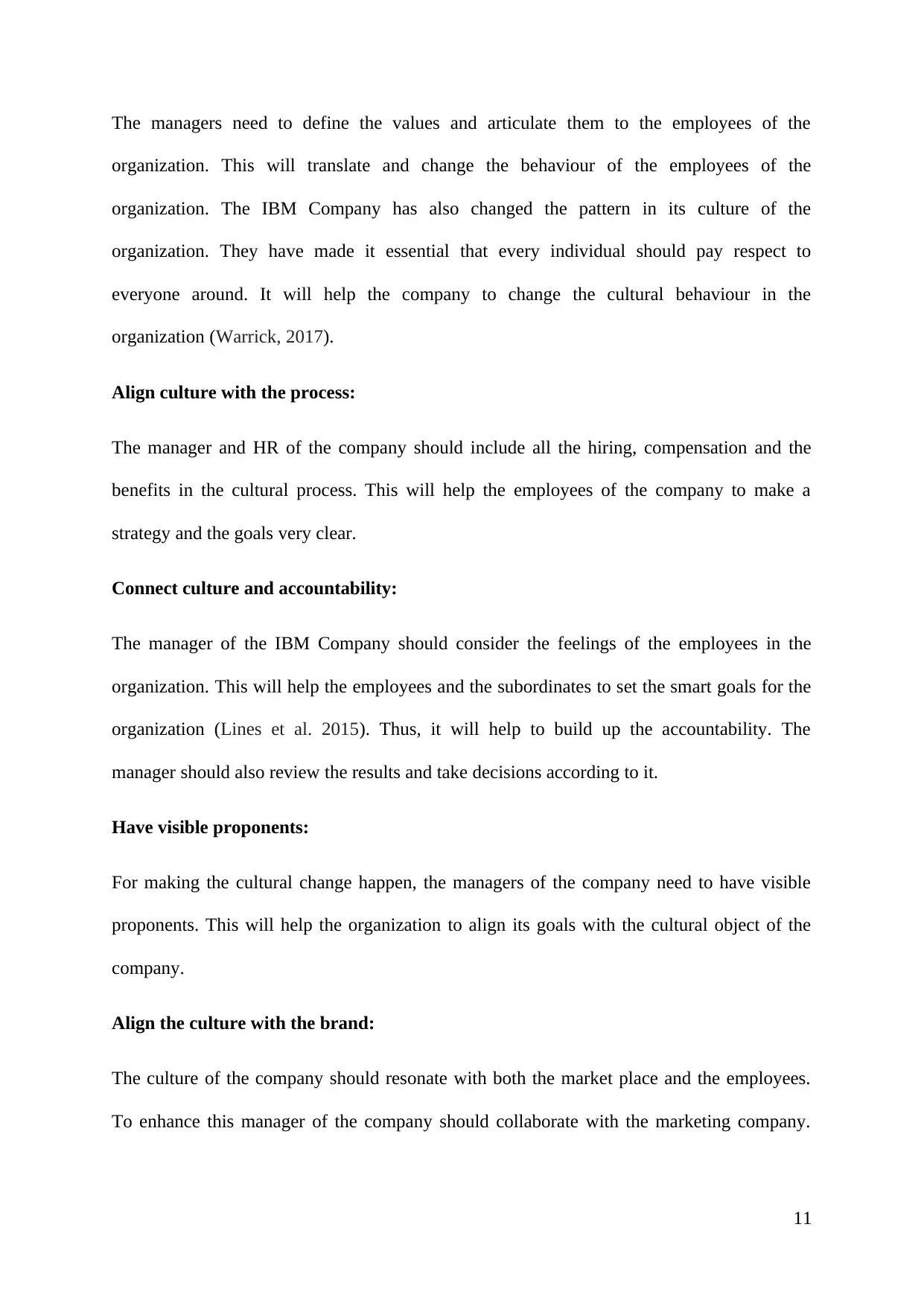
The managers need to define the values and articulate them to the employees of the
organization. This will translate and change the behaviour of the employees of the
organization. The IBM Company has also changed the pattern in its culture of the
organization. They have made it essential that every individual should pay respect to
everyone around. It will help the company to change the cultural behaviour in the
organization (Warrick, 2017).
Align culture with the process:
The manager and HR of the company should include all the hiring, compensation and the
benefits in the cultural process. This will help the employees of the company to make a
strategy and the goals very clear.
Connect culture and accountability:
The manager of the IBM Company should consider the feelings of the employees in the
organization. This will help the employees and the subordinates to set the smart goals for the
organization (Lines et al. 2015). Thus, it will help to build up the accountability. The
manager should also review the results and take decisions according to it.
Have visible proponents:
For making the cultural change happen, the managers of the company need to have visible
proponents. This will help the organization to align its goals with the cultural object of the
company.
Align the culture with the brand:
The culture of the company should resonate with both the market place and the employees.
To enhance this manager of the company should collaborate with the marketing company.
11
organization. This will translate and change the behaviour of the employees of the
organization. The IBM Company has also changed the pattern in its culture of the
organization. They have made it essential that every individual should pay respect to
everyone around. It will help the company to change the cultural behaviour in the
organization (Warrick, 2017).
Align culture with the process:
The manager and HR of the company should include all the hiring, compensation and the
benefits in the cultural process. This will help the employees of the company to make a
strategy and the goals very clear.
Connect culture and accountability:
The manager of the IBM Company should consider the feelings of the employees in the
organization. This will help the employees and the subordinates to set the smart goals for the
organization (Lines et al. 2015). Thus, it will help to build up the accountability. The
manager should also review the results and take decisions according to it.
Have visible proponents:
For making the cultural change happen, the managers of the company need to have visible
proponents. This will help the organization to align its goals with the cultural object of the
company.
Align the culture with the brand:
The culture of the company should resonate with both the market place and the employees.
To enhance this manager of the company should collaborate with the marketing company.
11
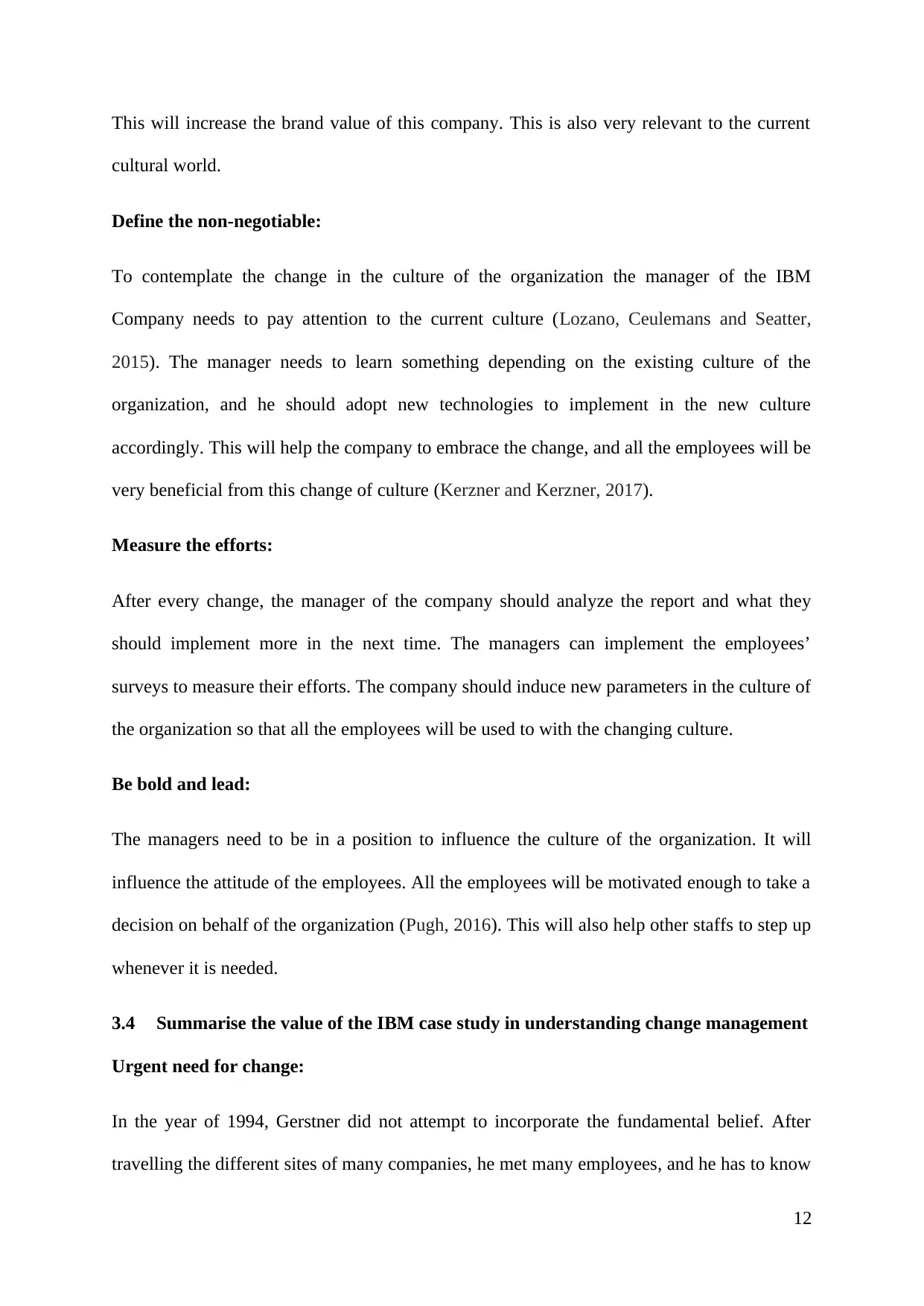
This will increase the brand value of this company. This is also very relevant to the current
cultural world.
Define the non-negotiable:
To contemplate the change in the culture of the organization the manager of the IBM
Company needs to pay attention to the current culture (Lozano, Ceulemans and Seatter,
2015). The manager needs to learn something depending on the existing culture of the
organization, and he should adopt new technologies to implement in the new culture
accordingly. This will help the company to embrace the change, and all the employees will be
very beneficial from this change of culture (Kerzner and Kerzner, 2017).
Measure the efforts:
After every change, the manager of the company should analyze the report and what they
should implement more in the next time. The managers can implement the employees’
surveys to measure their efforts. The company should induce new parameters in the culture of
the organization so that all the employees will be used to with the changing culture.
Be bold and lead:
The managers need to be in a position to influence the culture of the organization. It will
influence the attitude of the employees. All the employees will be motivated enough to take a
decision on behalf of the organization (Pugh, 2016). This will also help other staffs to step up
whenever it is needed.
3.4 Summarise the value of the IBM case study in understanding change management
Urgent need for change:
In the year of 1994, Gerstner did not attempt to incorporate the fundamental belief. After
travelling the different sites of many companies, he met many employees, and he has to know
12
cultural world.
Define the non-negotiable:
To contemplate the change in the culture of the organization the manager of the IBM
Company needs to pay attention to the current culture (Lozano, Ceulemans and Seatter,
2015). The manager needs to learn something depending on the existing culture of the
organization, and he should adopt new technologies to implement in the new culture
accordingly. This will help the company to embrace the change, and all the employees will be
very beneficial from this change of culture (Kerzner and Kerzner, 2017).
Measure the efforts:
After every change, the manager of the company should analyze the report and what they
should implement more in the next time. The managers can implement the employees’
surveys to measure their efforts. The company should induce new parameters in the culture of
the organization so that all the employees will be used to with the changing culture.
Be bold and lead:
The managers need to be in a position to influence the culture of the organization. It will
influence the attitude of the employees. All the employees will be motivated enough to take a
decision on behalf of the organization (Pugh, 2016). This will also help other staffs to step up
whenever it is needed.
3.4 Summarise the value of the IBM case study in understanding change management
Urgent need for change:
In the year of 1994, Gerstner did not attempt to incorporate the fundamental belief. After
travelling the different sites of many companies, he met many employees, and he has to know
12
⊘ This is a preview!⊘
Do you want full access?
Subscribe today to unlock all pages.

Trusted by 1+ million students worldwide
1 out of 18
Related Documents
Your All-in-One AI-Powered Toolkit for Academic Success.
+13062052269
info@desklib.com
Available 24*7 on WhatsApp / Email
![[object Object]](/_next/static/media/star-bottom.7253800d.svg)
Unlock your academic potential
Copyright © 2020–2025 A2Z Services. All Rights Reserved. Developed and managed by ZUCOL.




